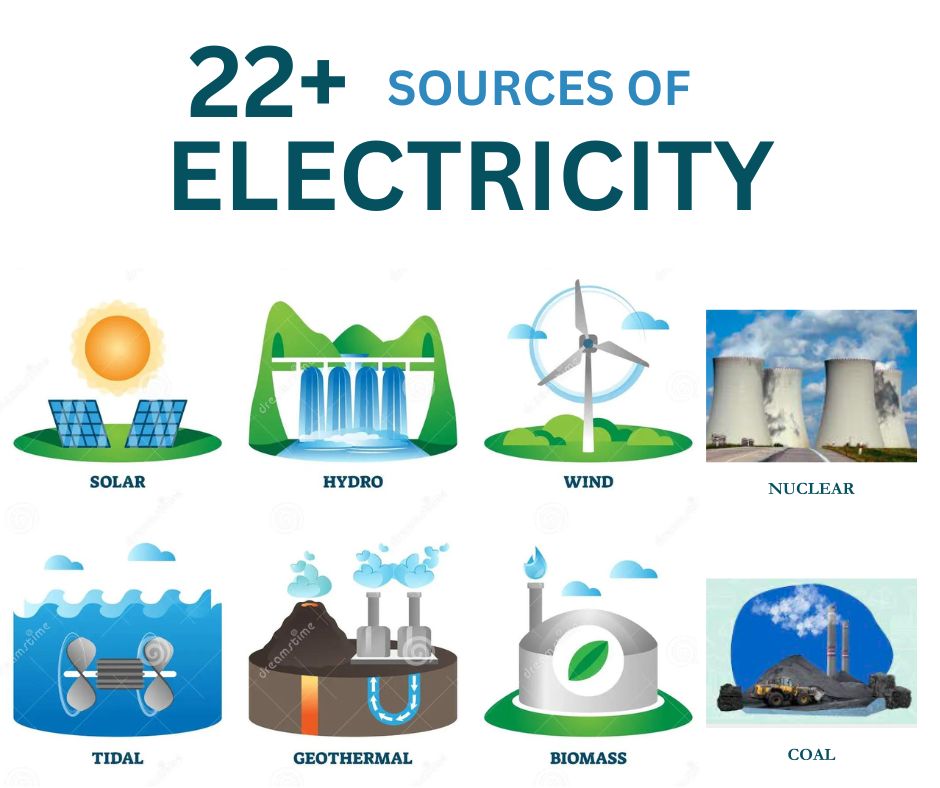Sources of Electricity: A Dive into Power Generation Methods
Introduction
Electricity is an essential part of modern life, powering our homes, businesses, and industries. We often take it for granted, but understanding where our electricity comes from is vital for a sustainable and efficient future. Various sources of electrical power generation play a critical role in meeting our energy needs. In this article, we will explore some of the primary sources of electricity, including batteries, generators, and solar cells.
Sources of Electricity

Batteries
Batteries are a portable and convenient source of electrical power. They are widely used in numerous applications, from powering small electronic devices like smartphones and laptops to larger systems such as electric vehicles and backup power supplies. Batteries store electrical energy chemically and convert it into electricity when needed.
Key types of batteries include:
- Lithium-Ion Batteries: These are the most common batteries used in portable electronics and electric vehicles due to their high energy density and reliability.
- Lead-Acid Batteries: Frequently used in automotive applications and uninterruptible power supplies (UPS), lead-acid batteries are cost-effective and robust.
- Nickel-Cadmium (Ni-Cd) Batteries: Ni-Cd batteries are known for their long cycle life and are commonly used in critical applications like medical devices and emergency lighting.
Batteries are a critical component of the growing renewable energy sector, allowing excess energy from sources like wind and solar to be stored for use during periods of low energy production.
Generators
Generators are devices that convert mechanical energy into electrical energy. They are essential for providing electricity when a reliable grid connection is unavailable or during power outages. Generators come in various types, such as diesel, natural gas, and propane generators, and they are widely used in commercial and industrial settings.
Key types of generators include:
- Portable Generators: These are commonly used for residential backup power and outdoor activities. They run on gasoline or propane and can be easily moved to the desired location.
- Standby Generators: These systems automatically kick in when the main power source fails. They are frequently used in critical facilities like hospitals and data centers to ensure uninterrupted power.
- Industrial Generators: Industrial-sized generators are used for large-scale power generation and are often connected to the electrical grid to provide additional capacity during peak demand.
Generators are an important component of emergency preparedness and provide a reliable source of power during unexpected electrical outages.
Solar Cells
Solar cells, or photovoltaic cells, are a rapidly growing source of electricity. They harness the power of the sun by converting sunlight directly into electricity through a process known as the photovoltaic effect. Solar cells are an environmentally friendly and renewable source of energy.
Key aspects of solar cells include:
- Solar Panels: These are the most common form of solar cell technology and are composed of numerous solar cells interconnected on a panel. Solar panels can be installed on rooftops, ground-mounted arrays, and integrated into building designs.
- Thin-Film Solar Cells: These are lighter and more flexible than traditional solar panels, making them suitable for a range of applications, including solar-powered calculators and portable chargers.
- Concentrated Solar Power (CSP): CSP technology uses mirrors or lenses to concentrate sunlight onto a small area to generate high-temperature heat, which is then used to produce electricity through turbines.
Solar energy is sustainable and eco-friendly, contributing to the reduction of greenhouse gas emissions and dependence on fossil fuels. It is increasingly being integrated into our energy mix to combat climate change and meet renewable energy goals.
Other Sources of Electricity
The quest for diverse and sustainable sources of energy has become a paramount concern in the face of environmental challenges and the finite nature of traditional fossil fuels. This article delves into a comprehensive exploration of various energy sources, ranging from conventional to renewable, each playing a pivotal role in shaping the landscape of global power generation. From the mighty forces harnessed by nuclear reactions to the gentle caress of wind creating electricity, the following lines aim to provide succinct insights into the characteristics and significance of each energy source.
As we navigate the complexities of our modern energy demands, understanding the intricacies of these diverse sources becomes crucial. This journey through the realms of energy will shed light on the mechanisms that power our homes, industries, and technological advancements, while also contemplating the environmental implications of our energy choices. Join us in this exploration of the tapestry of energy sources that fuel our world and the continuous pursuit of cleaner, more sustainable alternatives.
- Nuclear Power: Nuclear power harnesses energy from the nucleus of atoms through controlled nuclear reactions, producing significant amounts of electricity with low carbon emissions.
- Wind: Wind energy is generated by capturing the kinetic energy of moving air using wind turbines, converting it into electrical power, and making it a clean and renewable energy source.
- Hydropower: Hydropower exploits the energy of flowing or falling water to generate electricity, commonly achieved through dams or water turbines, providing a reliable and sustainable power source.
- Renewable Energy: A broad category encompassing various sources like solar, wind, and hydropower, renewable energy is derived from naturally replenishing resources, reducing environmental impact and dependence on finite fossil fuels.
- Hydroelectricity: Hydroelectricity involves converting the energy of flowing water into electricity, utilizing the gravitational force to turn turbines and generate power, making it a reliable and widely used energy source.
- Coal: Coal is a fossil fuel formed from plant remains, and its combustion releases energy, primarily used in power plants for electricity generation, although it’s a major contributor to greenhouse gas emissions.
- Power Station: A power station is a facility that generates electricity through various methods like burning fossil fuels, nuclear reactions, or renewable sources, playing a crucial role in providing electricity for various applications.
- Fuel: Fuels like gasoline, diesel, and natural gas serve as energy sources in transportation and power generation, releasing energy through combustion reactions and contributing to both conventional and renewable energy systems.
- Solar: Solar energy harnesses the power of sunlight using photovoltaic cells to convert sunlight into electricity, offering a sustainable and abundant source of clean energy.
- Natural Gas: Natural gas, composed mainly of methane, is a fossil fuel commonly used for electricity generation and heating, with lower carbon emissions compared to coal and oil.
- Biomass: Biomass energy is derived from organic materials, such as wood, crop residues, and animal waste, which are burned or converted into biofuels to produce electricity and heat.
- Power: Power, in the context of electricity generation, refers to the rate at which energy is generated or consumed, with various sources contributing to the overall power supply.
- Geothermal Energy: Geothermal energy taps into heat from the Earth’s interior, using steam or hot water to generate electricity, providing a consistent and environmentally friendly energy source.
- Tidal Energy: Tidal energy captures the kinetic energy of ocean tides, utilizing the rise and fall of tides to generate electricity through various technologies like tidal stream generators.
- Solar Power: Solar power is generated by converting sunlight into electricity using photovoltaic cells, offering a sustainable and increasingly cost-effective solution for residential, commercial, and industrial applications.
- Wave Power: Wave power captures energy from the motion of ocean waves, converting it into electricity through devices like oscillating water columns or point absorbers.
- Water: Water, as a resource, is crucial for various energy sources, including hydropower and tidal energy, highlighting its significance in renewable energy generation.
- Photovoltaics: Photovoltaics involve the direct conversion of sunlight into electricity using semiconductor materials, commonly found in solar panels, offering a clean and efficient energy solution.
- Wind Turbine: A wind turbine is a device that converts wind energy into electricity by rotating blades connected to a generator, playing a key role in wind power generation.
- Solar Thermal Energy: Solar thermal energy captures the heat from sunlight to produce steam, driving turbines or engines to generate electricity, providing an alternative approach to harness solar power.
- Gas: Gas, including natural gas, is used as a fuel for electricity generation and various industrial processes, offering a cleaner alternative to some fossil fuels.
- Petroleum: Petroleum, a fossil fuel, is primarily used for transportation fuels and as a feedstock for the petrochemical industry, contributing to various energy-related applications.
These concise descriptions offer a glimpse into the diverse array of energy sources and their contributions to the global energy landscape.
FAQs
Which type of solar battery is the best?
Lithium-ion batteries, particularly lithium iron phosphate (LiFePO4), are considered one of the best choices for solar energy storage due to their high energy density, long cycle life, and efficiency.
What is the latest solar panel technology?
The latest solar panel technologies include heterojunction (HJT) and perovskite solar cells, which offer higher efficiency and lower production costs.
What are the different types of lithium-ion batteries for solar panels?
Common lithium-ion battery types for solar panels include LiFePO4, lithium manganese oxide (LiMn2O4), and lithium nickel cobalt manganese oxide (LiNiMnCoO2).
Why is a lithium-ion battery the best?
Lithium-ion batteries are considered the best due to their high energy density, lightweight design, long cycle life, and low self-discharge rate, making them ideal for many applications.
Which lithium battery is best?
The choice of the best lithium battery depends on the specific application. Lithium iron phosphate (LiFePO4) batteries are often favored for solar and renewable energy storage.
Is a lithium battery better for solar?
Yes, lithium batteries are often preferred for solar energy storage due to their efficiency, longer lifespan, and ability to provide a steady and reliable power source.
Is a lithium-ion battery good for solar?
Yes, lithium-ion batteries are a good choice for solar due to their ability to store excess energy during sunny periods for use during low-sunlight hours.
Which solar panel is more powerful?
The power of a solar panel is measured in watts (W). High-efficiency monocrystalline panels tend to be more powerful than other types, producing more watts per square foot.
Conclusion
Understanding the various sources of electrical power generation is crucial in today’s world, where energy consumption continues to rise, and the need for sustainable and reliable sources of electricity is paramount. Batteries, generators, and solar cells are just a few examples of the diverse methods used to produce electricity. As we continue to seek cleaner and more efficient ways to generate power, these sources will play an increasingly important role in shaping our energy landscape and driving us toward a more sustainable and electrified future.
In the grand tapestry of energy, our exploration has traversed the realms of nuclear power, wind, hydropower, and an array of other sources that illuminate our homes and power our technologies. From the colossal might of hydropower to the intricate dance of electrons in photovoltaic cells, each energy source has left an indelible mark on the landscape of power generation.
As we conclude this journey, it becomes evident that our choices in harnessing energy carry profound implications for the planet. The need for sustainability and a transition towards cleaner alternatives looms large on the horizon. Renewable sources, with their promise of low environmental impact, now stand as beacons guiding us towards a future where energy is not merely a commodity but a conscientious choice.
In the dynamic interplay between traditional fossil fuels and the burgeoning field of renewables, the future of energy lies in our hands. Through innovation, policy shifts, and a collective commitment to a greener tomorrow, we can forge a path where the lights never dim, and the wheels of progress turn sustainably. As we bid farewell to this exploration, let it serve as a reminder that the power to shape our energy future rests with each individual and every decision made today echoes in the energy landscape of tomorrow.
 Electrical Engineering World Wiring a Brighter Tomorrow!
Electrical Engineering World Wiring a Brighter Tomorrow!


